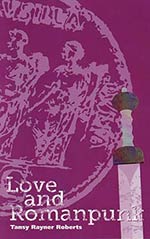
![]() ersandoval
ersandoval
11/20/2013
![]()
I'm not a big reader of short fiction—I guess my sense of appreciation isn't calibrated for the usual hit rate of a good anthology—but this collection by Tansy Rayner Roberts was wonderful.
Love and Romanpunk begins with "Julia Agrippina's Secret Family Bestiary," in which, Julia says, "I have arranged the secrets of my family in alphabetical order, beast by beast." These family tales, told in Julia's wonderfully dry voice, weave together into a fantastical and very unexpected version of Roman history where the monsters not only plagued Julia's family, they were her family.
The second story, "Lamia Victoriana," was probably my least favorite of the collection, though still quite good. I think I'd have enjoyed it more if I was better versed in the classics. The story is narrated by Fanny Wollstonecraft, as she and her sister Mary run away with an unnamed poet and his sister. They are, of course, the titular lamia, seductive vampires in the old Victorian sense, and a lovely, spine-chilling change from the modern kind. There's an unexpected tie to Rome at the end, which I didn't entirely understand at the time, but which sets things up nicely for the last two stories.
"The Patrician" was my favorite. Set in modern-day Nova Ostia, a fictional replica Roman city in Australia, made with real stone from Ostia and Herculaneum. That part's important, because the stone attracts the beasts of Rome, giving the residents more than their fair share of monsters. Sixteen-year-old Clea meets a stranger shortly before the Temple of Vesta burns down, killing two. It was the stranger, of course, a man named Julius, and the dead women lamia. He is the last of the Julias, and his task is to rid the world of the beasts of Rome. He saves her brother from a third lamia, and disappears. He reappears periodically throughout Julia's life, killing monsters, and gradually revealing the story of his life, and becoming a part of hers. I will admit, the ending tugged at my heartstrings more than a little.
The final story, "Last of the Romanpunks," picks up with Clea's grandson Sebastian, in an Ancient-Roman-themed bar on an airship–incidentally, owned by his ex-girlfriend, who is intent on bringing back the lamias Julius wiped out, and becoming one herself. Fortunately, Seb learned a few things from his grandma, and the Julias never truly die.
Each story could stand on its own, but I loved the way they all connected, making a whole greater than the sum of its parts. I may not know a lot of Roman history, but I could feel the author's love of the subject in every line. The monsters and monster-hunters may have been larger than life, but the ordinary people on the sidelines, Clea in particular, felt very real. Love and Romanpunk is smart, witty, surprising, and very much worth a read.